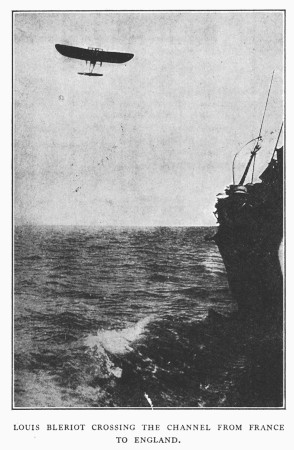Crossing the English Channel
Today, we'll try to cross the English Channel. The University of Houston's College of Engineering presents this series about the machines that make our civilization run, and the people whose ingenuity created them.
For thousands of years the English Channel has been a barrier that's tantalized people. It's a neck of cold, forbidding waters, as little as 21 miles wide, separating Europe from England. We hear Shakespeare saying to Henry the Fifth's army:
And thence to France shall we convey you safe,
And bring you back, charming the narrow sea,
to give you gentle pass.
When Hitler stared across the Channel in 1941, he found those 21 miles too far to go.
So it's not surprising that people have looked at many means for getting themselves across. The first time the channel yielded to anything other than a boat was over 200 years ago. That was Blanchard's balloon-crossing in 1785 -- a little over a year after the first balloon ascent was made in Paris.
The most primitive means for crossing the channel, of course, is swimming. And it's odd that we have no records of anyone trying that before 1872 -- a century after it was flown. The first person to succeed was Matthew Webb, who swam it three years later, in 1875. It took him 22 hours.
Like ballooning, heavier-than-air flight was attracted to the Channel almost immediately. In 1908 the London Daily Mail offered a £1000 prize for the first Channel flight. That was only five years after the Wright brothers and only two years after the first European flight. The Frenchman Louis Bleriot won the prize a year later.
And in 1979 a strange 75-pound airplane called the Gossamer Albatross won the £100,000 Kremer prize for the first human-powered flight over the Channel. For three hours, pilot Bryan Allen pedaled its propeller and flew it into the record books.
All this makes us wonder, what next! Well, I'll tell you what's next. Tunneling has already started under the Channel. Two main train tunnels with a smaller access tunnel between them are being drilled through the chalk marl under the Channel. This joint English/French project will cost 10 billion dollars. Tunnels reaching out from both Folkestone and Calais are to be joined in the Summer of 1990.
The idea of tunneling isn't new. The English and French began one in 1881; but the British aborted it for fear it could serve the French as an invasion route. The British started a another one 15 years ago but had to abandon it for lack of money.
I suppose the next project'll be a bridge -- not that it strikes me as practical. It just seems like the kind of challenge engineers won't be able to resist indefinitely.
I'm John Lienhard, at the University of Houston, where we're interested in the way inventive minds work.
(Theme music)
For more on the matter of tunneling (especially tunnelling under the English Channel) see the proceedings of the Smithsonian Institution's symposium on its tunneling exhibition, Down Under: Tunnels Past, Present, and Future, National Museum of American History, Saturday, October 23, 1993.
I say more about tunnelling as a metaphor in Episodes 51, 664, 849 and 855. For a more technical look at tunnelling, try the search function, using the word "tunnel".
This episode has been substantially rewritten as Episode 1390.

(From the 1832 Edinburgh Encyclopaedia)
Blanchard's hydrogen balloon with paddles for navigation

(From a 1910 magazine article)
Bleriot's flight across the English Channel